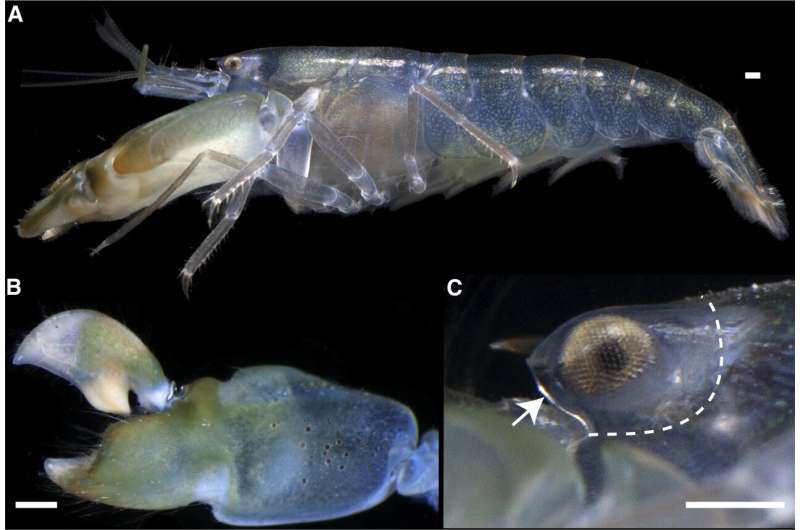July 7, 2022 report
Snapping shrimp orbital hood protects against shockwave blasts

A team of researchers from the University of Tulsa and the University of South Carolina, has found that the reason bigclaw snapping shrimp do not suffer from their own shock waves is that they are protected by orbital hoods. In their paper published in the journal Current Biology, the group describes experiments they conducted in their lab that involved removing the hoods from wild shrimp.
Prior research has shown that snapping shrimp are capable of generating supersonic, high-amplitude pressure (shock) waves using their claws. They clamp their claws quickly when approaching prey, resulting in the creation of popping bubbles accompanied by a snapping sound. The snapping sound is caused by a shock wave. These shock waves can damage organs and tissues in nearby creatures, making them much easier to catch. In this new effort, the researchers wondered why the shrimps that create the shock waves are not harmed by them, even when they are generated by others of their kind. To find out, they captured 60 of the creatures and brought them back to their lab for study.
Suspecting that the orbital hood that covers the head of the shrimp played a protective role, the researchers cut them off several of the creatures. They found that cutting off the hood did not seem to impact the shrimp during normal activities. But when they generated shockwaves to stun nearby prey, their behavior changed immediately. They jolted as if stung by a bolt of electricity, spun around, and sometimes fell over. Afterward, they moved oddly and had difficulty navigating back to their shelter—several appeared to get lost altogether. In sharp contrast, control shrimp with intact orbital hoods exposed to the shock waves behaved normally.
The researchers examined the hoods and found that the water pressure inside of them was lower than the water pressure outside. Also, the hoods had holes that allowed water to exit during a shockwave blast, directing the energy away from the brain and eyes. The researchers note that their finding is the first to identify biological features that protect against shock waves.
More information: Alexandra C.N. Kingston et al, Snapping shrimp have helmets that protect their brains by dampening shock waves, Current Biology (2022). DOI: 10.1016/j.cub.2022.06.042
Journal information: Current Biology
© 2022 Science X Network



















